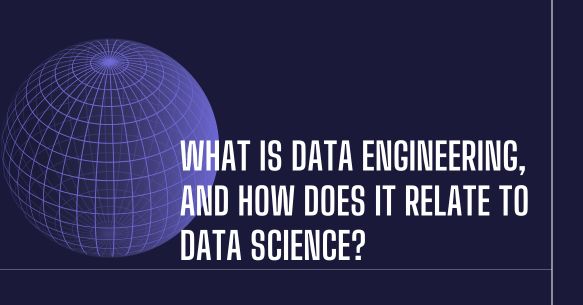
In today's data-driven world, organisations increasingly rely on data to make data-driven decisions. Improve products and drive business growth Two key roles help organisations unlock the value of their data: Data engineering. and data science Both roles, though, are critical to the success of modern data-driven initiatives. But they serve different but complementary purposes.
What is Data Engineering?
Data Engineering involves designing, building, and managing the systems and infrastructure that allow data to be collected, stored, processed, and made accessible for analysis. It focuses on creating and maintaining the architecture and pipelines that transform raw data into clean, structured, and usable datasets. These datasets can then be used by data scientists, analysts, and other stakeholders for decision-making, predictive modelling, and reporting.
Key Responsibilities of a Data Engineer:
- Data Collection and Integration: Data engineers are responsible for sourcing data from internal and external systems, APIs, and databases. They integrate various data sources into a unified platform, ensuring that data is collected reliably and promptly.
- Data Storage and Management: Data must be stored in an efficient and scalable manner. Data engineers design and manage databases, data warehouses, and data lakes capable of holding large amounts of structured and unstructured data. These systems ensure that data is organised, easily accessible, and secure.
- ETL (Extract, Transform, Load) Processes: One core task of data engineers is to implement ETL pipelines, which move data from source systems to target databases or data lakes. The “Transform” step involves cleaning, standardising, and enriching the data to make it suitable for analysis.
- Data Quality Assurance: Ensuring the accuracy, consistency, and completeness of data is crucial. Data engineers develop validation and quality-check mechanisms to ensure that the data pipeline produces reliable outputs.
- Automation and Optimization: Data engineers automate repetitive processes and optimise data pipelines for speed and cost-efficiency, especially when working with large-scale datasets.
What is Data Science?
Data Science focuses on extracting valuable insights and knowledge from data. It is a multidisciplinary field that blends elements of statistics, mathematics, machine learning, and domain expertise to analyse and interpret complex datasets. Data scientists build predictive models, perform analyses, and develop algorithms that reveal hidden patterns, trends, and correlations in the data.
Key Responsibilities of a Data Scientist:
- Data Exploration and Analysis: Data scientists explore datasets to uncover insights, patterns, and trends. They often use statistical methods and data visualisation techniques to generate hypotheses and explore data.
- Building Predictive Models: Data scientists use machine learning algorithms to build models that predict future outcomes or automate decision-making processes. These models are applied in areas like recommendation systems, fraud detection, and customer segmentation.
- Data Visualization: Data scientists create visualisations—such as charts, graphs, and dashboards—to communicate findings in ways that are easy to understand and actionable for stakeholders.
- Hypothesis Testing: Data scientists apply statistical methods to test hypotheses and validate their models, ensuring that the insights and predictions they generate are statistically sound.
- Collaboration with Stakeholders: Data scientists often collaborate with business leaders, product managers, and other teams to align their analyses with organisational goals and help guide decision-making.
How Does Data Engineering Relate to Data Science?
While Data Engineering and Data Science are distinct fields, they are deeply interconnected and rely on each other for success. Here’s how they relate:
- Data Engineering Enables Data Science
For data science to be effective, the right data must be available, clean, and structured. This is where data engineering plays a crucial role. Data engineers build the infrastructure and pipelines that provide data scientists with access to the data they need for analysis. Without well-designed data pipelines, data scientists would spend most of their time cleaning and preparing data, rather than analysing it. In this way, data engineers lay the groundwork for data scientists to perform their tasks.
- Data Science Depends on Data Quality and Structure
Data engineers ensure that the data is of high quality and structured in a way that makes it usable for analysis. If the data is messy, incomplete, or poorly structured, data scientists will struggle to extract meaningful insights. Data engineering provides the foundation that data science needs to succeed.
- Collaboration Between Teams
Data engineers and data scientists often work closely together. For instance, a data scientist may need a specific dataset for modelling, which the data engineer is responsible for providing. Likewise, data engineers may need to optimise data pipelines to accommodate new requirements from data scientists. Effective communication and collaboration are essential to ensure that the right data is available, in the right format, and on time.
- Data Science Models Need Engineering to Scale
Once data scientists develop predictive models or algorithms, these models need to be deployed at scale in a production environment. Data engineers are responsible for integrating these models into production systems and ensuring they can handle large volumes of data in real time. Without data engineers, the models developed by data scientists may not be scalable or deployable in real-world settings.
- Continuous Feedback Loop
Data engineering and data science are ongoing processes that require continuous refinement. As new data sources are added or new processing requirements emerge, data engineers adjust the data pipeline. Similarly, data scientists may need to update models as new data becomes available. The collaboration between these two fields ensures that the data ecosystem remains agile and responsive to changing needs.
Key Differences Between Data Engineering and Data Science
While both fields are crucial to data-driven organisations, they focus on different stages of the data workflow:
- Data Engineering: Focuses on the infrastructure, architecture, and processes for collecting, storing, and processing data. It is centred around building systems that support data flow and ensuring that data is clean, structured, and accessible.
- Data Science: Focuses on analysing data to extract insights, make predictions, and drive decision-making. It requires expertise in statistical analysis, machine learning, and understanding the business problem at hand.
Conclusion











